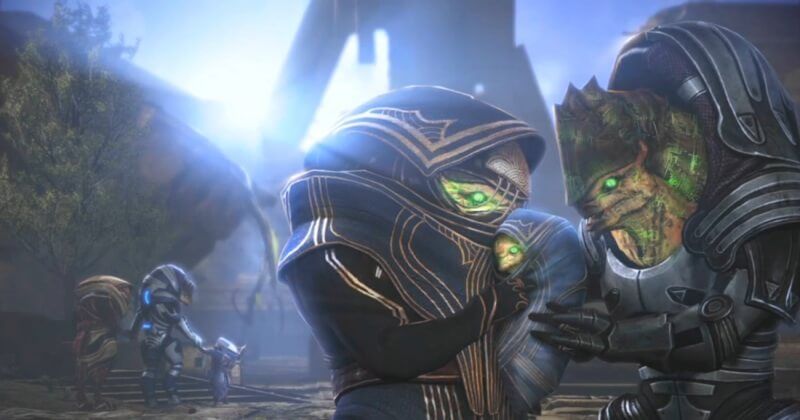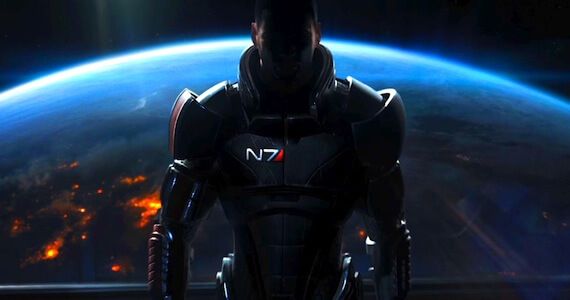The day jilted fans of Mass Effect 3 have been hoping for has finally arrived, bringing new ending scenes and details for each possible choice Commander Shepard can make. There's not a chance that every fan will now be satisfied and put the past behind them, but that doesn't mean BioWare hasn't held to their promise of giving the community what they felt entitled to.
With four total endings having been tweaked or overhauled in the name of variety and meaningful impacts, the more skeptical crowd may not wish to sit through videos of each conclusion, and certainly not play through Mass Effect 3's final moments all over again. So allow us to explain what each of the endings - Control, Synthesis, Destruction, and Refusal - has changed from the original. While most introduce new details and explanations that fans will no doubt appreciate, a few glaring questions still remain.
Extended Cut - Control Ending
Like most of the endings, the actual cutscenes leading up to Shepard's integration into the Reaper consciousness remain unchanged. Unlike before, Joker aboard the Normandy is now shown taking part in the battle in Earth's orbit, refusing to retreat as the Crucible begins to fire. Eventually he acquiesces, and the ship jumps out of the system.
From there, the same cinematic cutscene of the battle on Earth is shown, with the blue-lighting-storm bathing humans, Reapers, and their soldiers. The Reapers again immediately leave the surface of the planet, but a new scene shows a pair of soldiers being attacked by Reaper Husks. Once the blue wave of what seems to be Shepard's new influence reaches them, the Husks cower in fear and flee the scene.
The blue energy is again charged by Sol's Mass Relay, before firing off to the next in the chain. Addressing the questions raised by fans, the Mass Relay no longer experiences a series of explosion upon firing. In the Arrival DLC for Mass Effect 2, the destruction of a Mass Relay was shown to eradicate its entire system, which the fans pointed to as yet another case of the developers betraying their own fiction. Fan outrage or not, the previously included shot of the Relay was an inconsistency, and is now replaced by the orbiting rings of the Relay itself falling apart.
From there, the developers add shots of events similar to those that occurred on Earth taking place on the Asari and Krogan planets as well. Both armies rally as the now-blue Reapers pull their forces back, and the crew aboard the Normandy are shown still hard at work, Commander or no.
From there, the first drastic changes to the actual events of the ending occur. The Normandy had originally been shown fleeing the collapse of the Mass Relays, suffering explosions and loss of integrity as Joker tried to keep ahead of the blue energy wave. Now, no explosions or immediate danger is shown, simply the energy catching up to the ship. When the Normandy is shown downed on the jungle world, it is similarly intact, displaying none of the charred hull or wreckage of the original ending.
Thus ends the tweaking of the original elements, and the beginning of BioWare's major additions. Shepard now returns to narrate the exact circumstance of his integration with the Reapers, no longer "the man he was," but a new entity born of the merger. As the guiding will of the Reapers, having replaced whatever drove them to genocide in the name of "order," Shepard has put them to work rebuilding the Mass Relays. Regardless of personal feelings, the actual results we demanded on behalf of displeased fans are shown, and in great detail.
A slideshow of familiar faces - Jacob in his new role of authority, Jack with her students, Samara relaxing with her daughter, Falere - shows that not only has Krogan society begun to rebuild, but that they are now forming families and bearing children. Shepard confirms that he has successfully "harnessed the strengths of his enemy" to wield the Reapers as guardians of all sentient life.
The crew of the Normandy adds Shepard's name to the memorial on the ship, and takes off - together and in good condition - from the jungle world they had previously seemed stranded upon. The "stargazer" scene again caps off the conclusion, promising yet another story of "The Shepard." Once a man, now a force for good in the galaxy, the fairy tale theme certainly fits.
Extended Cut - Synthesis Ending
For those who chose to shrug off the nagging doubts of merging synthetic and organic life, and plunge headfirst into the blinding white beam of light, changes are also in store.
The same scene of the Reapers on Earth being bathed with the green light of synthesis is shown, again causing them to lift off the surface and retreat. The scene following the pair of soldiers attacked by Husks is also shown, but with some important changes. Once overtaken by the green energy, the Husk stops fighting, and joins the humans in gazing at the sun breaking through the cloud cover.
The green energy is once again transmitted through the Mass Relay, dismantling the rotating rings but leaving the body of the structure intact. The combination of organic and synthetic life is now illustrated further in the scenes that follow on both the Turian and Krogan planets. In both cases, the green energy doesn't just halt the Reapers' destruction, but causes the eyes of both races to glow green, along with portions of circuitry on the surface of their skin and armor.
The Normandy's lack of destruction plays out in the same way as the Control ending, with the narration now coming from EDI, not Shepard. New scenes give a brief look at organic/synthetic combination by showing polygonal structures overlaying human DNA, with EDI claiming that both forms of life have been altered, making her truly "alive." Now a common entity with the aliens they once fought, the Reapers are not just rebuilding after the war, but passing on all knowledge they possess to those who wish for it.
The same slideshow plays, though friends and allies now sport green skin and glowing eyeballs. A Geth soldier and Tali are shown as a physical example of the coexistence now transpiring on a genetic level between both.
As the Krogan build monuments outshining those of the past, the peace and technology shared among alien races ushers in a new age of progress and advancement -- an age that, EDI claims, may bring immortality to all. Shepard's name is once again placed beside Anderson's on the Normandy's memorial, before Liara embraces EDI as a friend among the now green-glowified crew, and the ship takes off.
Extended Cut - Destruction Ending
Choosing to wipe out the Reapers, and the Geth, and other synthetic life forms in the process, Shepard opens fire on the Crucible's power conduits, triggering a red wave of destruction rippling out from the machine. Joker again leaves only after being told repeatedly to do so, with the rest of the alien fleets jumping out of the system as the explosion spreads.
On Earth, the same cut-scene is shown from the original ending, with the Reapers collapsing to the ground as the red energy wave destroys them. The pair of soldiers seen in the previous endings now appear in a new scene, just moments from being overwhelmed by Husks when the red energy arrives, and reduces the attackers to ash.
The Asari and Krogan military watch as their planets' reserves of Reaper-metal suddenly skyrocket as well, and despite the wave's destructive properties, both the Normandy and the Mass Relay escape unscathed. The impact of Shepard's actions in this particular ending don't add any new story twists, so Admiral Hackett's post-war debriefing serve as epilogue.
The alien fleets are shown leaving on the same bearing as Earth's Mass Relay, relying on their own ships' power due to the "severely damaged" nature of the Relay itself. The complete and total victory now grants each race the freedom to do as they wish, with Hackett imagining what can be done in peace, after seeing what was accomplished in war.
These words of optimism are shown in images depicting a rebuilt London, and even a rebuilt Citadel in Earth's orbit. Whether a sign of what is truly to come or merely what might, those who were lost are once again paid tribute. Shepard's name is again added to the Normandy memorial - now naming EDI among the dead - and the crew takes flight.
For those who gathered enough war assets before the final fight, the same scene of the Crucible's wreckage from the original Destruction ending is shown. The same glimpse of N7 armor is shown, again cutting to black just after seeing the body inside the armor take a breath.
Shepard is apparently still allowed to live in one of the endings, but for those players who faced the glowing-Crucible-child and felt that the developers should have added an "I'll tell you where to stick your choices" option, you are now in luck.
Extended Cut - Refusal Ending
That's right, the new variety of Mass Effect 3 endings adds a "none of the above option" for those players who felt that humanity and its gathered allies would rather take their chances fighting annihilation than follow the paths set out by "ancient wisdom."
Refusing to choose the fate of every living or synthetic life form - as the Reapers do - Shepard claims that the races gathered would rather die free than be directed. The Reapers acquiesce, and the good Commander is forced to watch as Earth is overrun.
A fade to black then opens on a surface beacon, marking the underground location of the knowledge-time capsule Liara had been building in the game's campaign, should civilization fall before the Reapers. A holographic projection of Liara explains the construction and failure of the Crucible, and the uniting and collapse of all sentient life in the galaxy.
The civilizations that the players knew have now passed into memory, taking the same place once held by the Prothean as ancient beings who left behind little more than hope that the same destruction would not be brought on those who came after. Life paid the ultimate sacrifice for freedom, and in the end, the cycle of growth and death that the Reapers use to bring order to chaos won the day.
Not the most optimistic or gleeful ending, but certainly in keeping with the existing mythology of the series. No elderly stargazer and boy are present to tell the story of "The Shepard," but...humanity and its allies died with dignity.
It seems that if the player chooses to open fire on the child-like hologram of Reaper consciousness, a new ending is also unlocked. The cycle is also doomed to repeat itself, and Liara's time capsule is all that remains of Shepard's efforts. But following that scene is a new "Stargazer" epilogue, featuring two beings who do not seem to be human, claiming that the story was of a civilization whose wisdom did manage to bring peace.
That's got to be worth something.
-
Those are the differences we noticed in the brand new extended endings, but there may be smaller ones that were noticed by even more eagle-eyed fans. The variability of war assets may have varied some of the outcomes, but for now it seems these are the canon.
Are there any particular endings which you think elevate the conclusion of the series better than others? Think the poignancy of the Refusal ending might actually tempt you to consider playing through the game again, or will you be pursuing one of the "happy"endings? It could be argued that there are plenty "good" endings to choose from, so share your own thoughts in the comments.
The Mass Effect 3 Extended Cut DLC is available now, for no additional charge to owners.
Follow me on Twitter @andrew_dyce.


